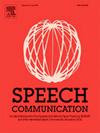梯度还是分类?汉语虚元音的语音类型学研究
IF 3
3区 计算机科学
Q2 ACOUSTICS
引用次数: 0
摘要
本文认为,在普通话中,非母语听者对两个辅音之间不存在的元音的错觉感知是梯度的,而不是绝对的,并且错觉的强度可以从非母语语音输入与听者的母语语音语法不匹配中预测出来。我们研究了五种语音情景,在这些情景中,不同质量的虚幻元音可以被感知,不同的幻觉水平可以通过音节语音限制、元音最小度以及虚幻元音与其前辅音之间的发音一致性等因素来预测。实验1和实验2对预测结果进行了验证,总体上证实了预测结果,但也观察到一些范式差异。通过比较目前的结果和以前的报告,我们认为梯度而不是分类的虚假元音更适合解释和预测非母语集群感知。具体而言,前辅音的发音位置特征对于预测上下文虚幻元音很重要,这反映了非母语听者对多个片段感知的手势分数的解释,支持直接现实主义的语言感知观点。本文章由计算机程序翻译,如有差异,请以英文原文为准。
Gradient or categorical? Towards a phonological typology of illusory vowels in Mandarin
This paper argues that illusory vowel perception, i.e., the perception of non-existent vowels between two consonants by nonnative listeners, is gradient rather than categorical in Mandarin Chinese, and that the strength of illusion is predictable from the mismatches between the nonnative speech input and the listeners’ native phonological grammar. We examined five phonological scenarios where illusory vowels with different qualities can be perceived, and different illusion levels can be predicted by factors including syllable phonotactic constraints, vowel minimality, and the place of articulation consistency between the illusory vowel and its preceding consonant. The predictions were examined in an AXB discrimination task (Experiment 1) and an identification task (Experiment 2), which confirmed the predictions overall, while some paradigmatic differences were also observed. By comparing the current results and previous reports, we argue that a gradient rather than categorical account of illusory vowel is more suitable for explaining and predicting nonnative cluster perception. Specifically, the place of articulation feature of the preceding consonant is important for predicting contextual illusory vowels, which reflects nonnative listeners’ interpretation of perceived gestural score across multiple segments, supporting a direct realist view of speech perception.
求助全文
通过发布文献求助,成功后即可免费获取论文全文。
去求助
来源期刊

Speech Communication
工程技术-计算机:跨学科应用
CiteScore
6.80
自引率
6.20%
发文量
94
审稿时长
19.2 weeks
期刊介绍:
Speech Communication is an interdisciplinary journal whose primary objective is to fulfil the need for the rapid dissemination and thorough discussion of basic and applied research results.
The journal''s primary objectives are:
• to present a forum for the advancement of human and human-machine speech communication science;
• to stimulate cross-fertilization between different fields of this domain;
• to contribute towards the rapid and wide diffusion of scientifically sound contributions in this domain.
 求助内容:
求助内容: 应助结果提醒方式:
应助结果提醒方式:


